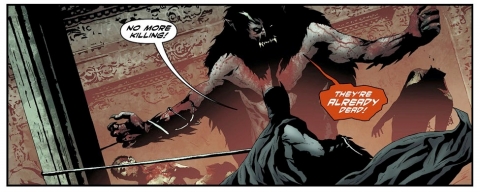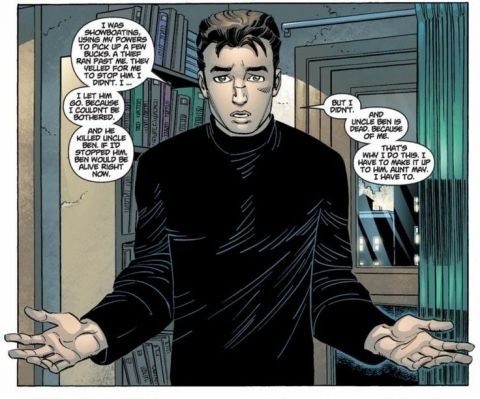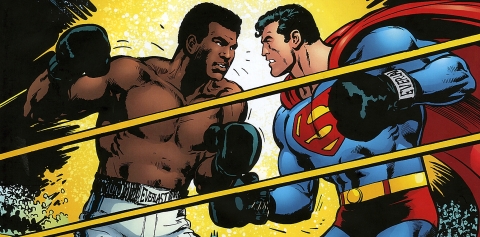52 weeks. 52 different writers. 2 trade paperbacks or hardcovers a week. Each week I’ll take a look at a different writer and read two different collected editions from within that person’s repertoire to help in the examination of their work.
Joshua Hale Fialkov is a writer who I wouldn’t refer to as a “big name” and I mean that in the kindest way possible. He’s a writer who has dabbled a bit with multiple publishers but has found his greatest amount of success working for Oni Press. The horror genre is an area Fialkov has been known to excel in, hence why he was a natural choice for DC Comics when they decided to have a title for I, Vampire with their New 52 relaunch back in 2011.
I, Vampire Vol 1: Tainted Love
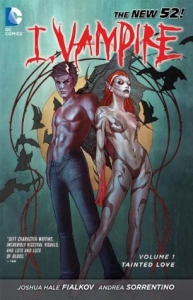 Andrew Bennett is a six hundred year old vampire trying his hardest to prevent an oncoming war between vampires and humans, as the vampires threaten to take away any human life from the world in one fell swoop. The task of stopping this war before it starts appears to be easier said than done as his former lover, Mary, is the leader of this new vampire regime hellbent on taking over the world. Mary, the Queen of Blood, is the only vampire powerful enough to rival Andrew’s own power and leaves him in an uncomfortable position when it comes to deciding how to stop her. The only way for Andrew to stop Mary is to kill her “maker” which, to make matters complicated, just so happens to be himself. Dying for Andrew proves to be far more difficult than one would anticipate as a vampire of Andrew’s age can’t necessarily be killed easily. Instead he must willingly decide to die if he wishes to perish and stop Mary dead in her tracks. Along the way, Andrew gathers longtime friends and unlikely allies like Professor Troughton, Tig, John Constantine, and even Batman, in his battle against Mary and her evil horde.
Andrew Bennett is a six hundred year old vampire trying his hardest to prevent an oncoming war between vampires and humans, as the vampires threaten to take away any human life from the world in one fell swoop. The task of stopping this war before it starts appears to be easier said than done as his former lover, Mary, is the leader of this new vampire regime hellbent on taking over the world. Mary, the Queen of Blood, is the only vampire powerful enough to rival Andrew’s own power and leaves him in an uncomfortable position when it comes to deciding how to stop her. The only way for Andrew to stop Mary is to kill her “maker” which, to make matters complicated, just so happens to be himself. Dying for Andrew proves to be far more difficult than one would anticipate as a vampire of Andrew’s age can’t necessarily be killed easily. Instead he must willingly decide to die if he wishes to perish and stop Mary dead in her tracks. Along the way, Andrew gathers longtime friends and unlikely allies like Professor Troughton, Tig, John Constantine, and even Batman, in his battle against Mary and her evil horde.
Joshua Hale Fialkov begins a supernatural epic of vampires versus humans with this first volume of I, Vampire. This first volume feels like the opening salvo of a three act play, setting all the major pieces into place before dramatically sweeping everything in a brand new direction by the end of the volume. Fialkov takes troublesome characters who want to do good and throws them together into a cauldron of rising tension, with an impending vampire takeover set as the backdrop. With the threat of an imminent war on the cusp of spilling over, Andrew Bennett and his unlikely alliances find themselves moving slowly towards a final showdown in Gotham City, which is as apt a place as any for a final battle against an army of mythological creatures who are most well-known for transforming into bats, especially because it provides the opportunity for THE most famous man associated with the symbol of a bat to step into the action.
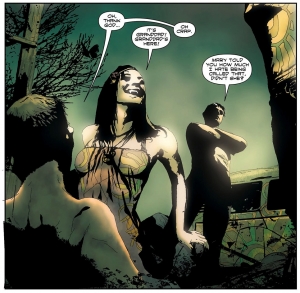 I, Vampire is an interesting book set within the DC Universe, feeling as though it shouldn’t exist in a superhero universe but it still does. In most instances, some of your best stories are non-superhero stories that occur in a superhero universe, with books like Sandman coming to mind as a fine example of such. Fialkov doesn’t seem content with telling a simple horror story with I, Vampire though, nor does he truly mix that many genres together, instead settling into a fairly straightforward supernatural action series that follows Andrew’s battle against vicious hordes of vampires set to take over the world instead of trying to strike fear into you because of the subject matter at hand. It’s a bold decision for Fialkov to cast the story in this light but it’s a direction that is reinforced by the inclusion of characters like the Vertigo/DC supernatural powerhouse John Constantine or even the brute force of a character like Batman. The story comes off as being hyper focused on getting from point A to point B in as direct a manner as possible, with any bits of the story that branch out serving to exclusively build up the cast of characters around Andrew so that he has allies in his final battle against Mary, the Queen of Blood. Fialkov does a fine job of building his characters up around the plot of his story, with nearly each issue taking a character centric focus that also pushes the plot further. In the first issue you learn about Andrew and the premise of the series. By issue two, you get a full story about Mary and why she is the antagonist opposite Andrew. From there the trend largely continues with Constantine guest staring in issue three as well as the reader being introduced to Professor Troughton, the character of Tig getting set up better in issue four, and Batman jumping on to the scene in issue five before everything culminates with almost all these characters going to war in the opening moments of issue six.
I, Vampire is an interesting book set within the DC Universe, feeling as though it shouldn’t exist in a superhero universe but it still does. In most instances, some of your best stories are non-superhero stories that occur in a superhero universe, with books like Sandman coming to mind as a fine example of such. Fialkov doesn’t seem content with telling a simple horror story with I, Vampire though, nor does he truly mix that many genres together, instead settling into a fairly straightforward supernatural action series that follows Andrew’s battle against vicious hordes of vampires set to take over the world instead of trying to strike fear into you because of the subject matter at hand. It’s a bold decision for Fialkov to cast the story in this light but it’s a direction that is reinforced by the inclusion of characters like the Vertigo/DC supernatural powerhouse John Constantine or even the brute force of a character like Batman. The story comes off as being hyper focused on getting from point A to point B in as direct a manner as possible, with any bits of the story that branch out serving to exclusively build up the cast of characters around Andrew so that he has allies in his final battle against Mary, the Queen of Blood. Fialkov does a fine job of building his characters up around the plot of his story, with nearly each issue taking a character centric focus that also pushes the plot further. In the first issue you learn about Andrew and the premise of the series. By issue two, you get a full story about Mary and why she is the antagonist opposite Andrew. From there the trend largely continues with Constantine guest staring in issue three as well as the reader being introduced to Professor Troughton, the character of Tig getting set up better in issue four, and Batman jumping on to the scene in issue five before everything culminates with almost all these characters going to war in the opening moments of issue six.
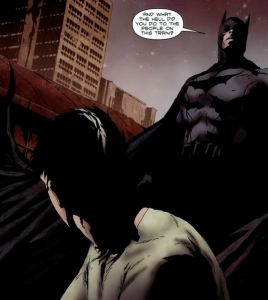 The way Fialkov chooses to tell the story greatly attributes to you enjoying at least a few of the character interpretations presented for you. There are plenty of aspects to characters that feel unnecessary or poorly fleshed out but, for the most part, you can take plenty of enjoyment from the story of Andrew and Mary. Fialkov elects to flesh out Andrew’s past but only to a certain point, with that point being where his past intersects with Mary’s future. We learn about the close personal tie he has to Mary and how, as a result, he feels as though it is his fault that Mary is as powerful as she is. Fialkov cleanly illustrates that Andrew is the cause and the solution to his own Mary problem, which in and of itself helps to further hammer home that point that Andrew is technically still a monster, even though he has a heightened sense of humanity. The same can largely be said for Mary wherein Fialkov demonstrates that the position she is in is essentially Andrew’s fault and that without the previous influence of Andrew, Mary would never have been capable of reaching a position of power in the first place. You can understand why she is acting that way she is but still understand that, at a base level, everything she is seeking to achieve is incredibly evil. It’s disappointing to see how much Fialkov actually peels back from this relationship dynamic around the midway part of the story but it’s also an understandable direction as to keep returning to the same well for storytelling possibilities would just result in diminishing returns.
The way Fialkov chooses to tell the story greatly attributes to you enjoying at least a few of the character interpretations presented for you. There are plenty of aspects to characters that feel unnecessary or poorly fleshed out but, for the most part, you can take plenty of enjoyment from the story of Andrew and Mary. Fialkov elects to flesh out Andrew’s past but only to a certain point, with that point being where his past intersects with Mary’s future. We learn about the close personal tie he has to Mary and how, as a result, he feels as though it is his fault that Mary is as powerful as she is. Fialkov cleanly illustrates that Andrew is the cause and the solution to his own Mary problem, which in and of itself helps to further hammer home that point that Andrew is technically still a monster, even though he has a heightened sense of humanity. The same can largely be said for Mary wherein Fialkov demonstrates that the position she is in is essentially Andrew’s fault and that without the previous influence of Andrew, Mary would never have been capable of reaching a position of power in the first place. You can understand why she is acting that way she is but still understand that, at a base level, everything she is seeking to achieve is incredibly evil. It’s disappointing to see how much Fialkov actually peels back from this relationship dynamic around the midway part of the story but it’s also an understandable direction as to keep returning to the same well for storytelling possibilities would just result in diminishing returns.
Your secondary characters of the story are perhaps the weakest element that Fialkov sets forward, with none of them feeling fleshed out or believable. It’s one thing to make strong leads in favour of lesser secondary characters, but it’s a whole other problem when these secondary characters hardly register as blips on the radar yet they are still placed in positions to make important decisions that will alter the narrative going forward. The biggest example of this is the character of Tig, who pops up about halfway through the story and is forced upon the reader because of a contingent role she plays towards the end of the volume. Fialkov hits you with a “twist” involving the character that could not hit you more flatly than it does, with you as the reader expected to relish in a moment of a sudden payoff (and coincidentally setup) that just does nothing for you whatsoever. She’s an unnatural character that the reader struggles to connect with and then is made to feel as though they have to because of something that changes her life forever. This is all meant to leave the reader with some semblance of a reward within the fleeting pages of the volume when she makes a major decision, but instead she just comes off like a crazy female for much of her time in the story and really stays that way even through the game changing event that unfolds. Moments removed from reading the story as I write this, your secondary characters like Troughton and Tig just feel forgettable and woefully unnecessary in a story that already had plenty of heart and fangs shared between the two leads who had a tragic as well as mildly intricate relationship that propelled the entire premise of this series forward.
Collects: I, Vampire #1-6
Best Character: Andrew Bennett
Best Line Of Dialogue/Caption: “Today is a big day. And we start each day right. With a very…very…healthy breakfast.” – Mary
Best Scene/Moment: Andrew discovers things aren’t what they seem – Issue 1
Best Issue: Issue 1. Issue 1 is a cool cyclical story that comes all back around by its final page. You’re introduced to your protagonist and antagonist, given a clear idea of what’s to come as well as what both sides are working towards, and the book looks absolutely gorgeous thanks to Andrea Sorrentino. The book does a great job of deceiving the reader, convincing you that you know the story is going one way when it really veers in another direction. It’s a fairly complete tale that kicks off the story in the right direction and builds on it with a thoroughly entertaining and action packed second issue.
Why You Should Read It: I, Vampire is perfect for readers who enjoy stories set in a superhero universe that aren’t superhero stories. You see characters from that world pop up but their inclusion never makes the story feel like it’s a superhero tale, with Fialkov keeping everything planted firmly in the world of supernatural action. Andrew Bennett and Mary make for a strong hero and villain for this comic respectively and how Fialkov writes those two characters alone makes this story worth your time. If that’s not enough, Andrea Sorrentino is a simply wonderful artist on the book and someone who deserves all the attention in the world.
The Life After Vol 1
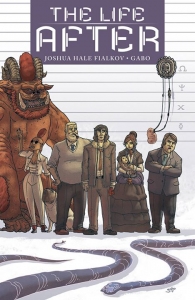 Joshua Hale Fialkov began working on a webseries titled “The Bunker” back in late 2013 with artist Joe Infurnari which was well received enough to get picked up and put into print by Oni Press in early 2014. Coming off the strength of The Bunker, Fialkov pitched another series to Oni Press and in mid-2014, The Life After was born with the artist Gabo attached to the project. 2014 wasn’t an entirely easy year for Fialkov though, as his new Marvel Comics series, Ultimate FF, was poorly received by fans and critics leading to its cancellation midway through its first arc. Even with that in mind, the multiple Harvey Award nominee has shown that his true strength lies in creator owned content with the freedom to create any sort of characters or worlds he wants, with today’s look at The Life After being a perfect example of that.
Joshua Hale Fialkov began working on a webseries titled “The Bunker” back in late 2013 with artist Joe Infurnari which was well received enough to get picked up and put into print by Oni Press in early 2014. Coming off the strength of The Bunker, Fialkov pitched another series to Oni Press and in mid-2014, The Life After was born with the artist Gabo attached to the project. 2014 wasn’t an entirely easy year for Fialkov though, as his new Marvel Comics series, Ultimate FF, was poorly received by fans and critics leading to its cancellation midway through its first arc. Even with that in mind, the multiple Harvey Award nominee has shown that his true strength lies in creator owned content with the freedom to create any sort of characters or worlds he wants, with today’s look at The Life After being a perfect example of that.
Jude is an average man stuck in the monotonous cycle of life. Every morning he is woken up three minutes before his alarm goes at 6am, robbed of three precious, long stretching minutes of sleep. He gets on the bus to work which is always five minutes late and ends up stuck in gridlock traffic for what seems like an eternity. Everyday the same curious women gets off the bus at the same stop and drops a red handkerchief just as she stands, with Jude always paralyzed to inaction when he truly wants to give the Miss her unknowingly discarded object and strike up a whirlwind romance with this stranger. When Jude arrives at work he does the same unimportant paperwork that is actually somehow significant even though no one knows why, before finally heading home to sleep until the next morning so he can do it all over again. But one day, Jude finally decides to shake this trend, gaining the courage to give chase to the lady who repeatedly loses her handkerchief every morning. Narrowly escaping the bus at a location well before his actual stop, Jude catches up to the lady but when he touches her skin he sees an incredibly vivid series of memories that reveal she is from an entirely different time period, during which she had killed herself. Jude’s eyes are finally opened to the world around him when he realizes that this mundane world he exists in is actually entirely fictional, discovering that he now resides in a realm that is purgatory for people who have committed suicide. Eager to find answers and help the seemingly millions of other people trapped in the same vicious cycle he was in, Jude sets off with Ernest Hemingway in hope of some sort of resolution. Unbeknownst to Jude, he is being watched by the people who run this “purgatory” and they aren’t happy one bit with what he’s trying to do.
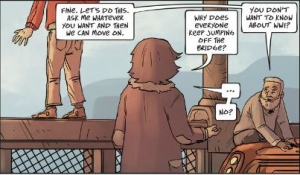 Joshua Hale Fialkov takes a the simple concept of eternal balance and shifts it in ways unexplored to provide readers with what is perhaps one of the most imaginative comics they’ll have read in the last decade with The Life After. Fialkov takes the concept of Heaven and Hell, with Heaven being a place where good people go to die and Hell the place for bad people, and shows the reader the grey area in between the two fictionalized locations by providing a series of purgatories for people who don’t necessarily fit into an easily grouped class. Purgatory is essentially the area between Heaven and Hell, with Fialkov starting readers off with purgatory for people who have committed suicide, with the idea that the act of taking one’s own life not making you an inherently evil person, which would result with you going straight to Hell, nor does it make you a good person and grant you passage to Heaven. It’s so hilariously simple to grasp but Fialkov writes it all in a way where you do need to actually think about what he’s putting in front of you instead of just taking it at a surface layer. Fialkov goes even further with what he tries to say to the reader with the portrayal of this purgatory being a layered structure, not meant to exclusively house people who just commit suicide but other people or creatures that undertake acts that leave them in the middle ground of generalization instead of easily casting them as good or evil. A clear example of this is when Jude discovers a “sector” where there are men and women working endlessly as miners. This area is quickly shown to represent people who stole something but for a good cause, with one man’s story being told brilliantly in a single silent page and illustrating that his family was starving so he stole a sheep, only to then feel guilty about stealing and return the sheep, to then return home and discover that one of his children had passed away from starvation. The entire plot of this comic is strikingly similar to the very concept of purgatory that Fialkov crafts in that both are multi-layered and afford you different interpretations as a reader.
Joshua Hale Fialkov takes a the simple concept of eternal balance and shifts it in ways unexplored to provide readers with what is perhaps one of the most imaginative comics they’ll have read in the last decade with The Life After. Fialkov takes the concept of Heaven and Hell, with Heaven being a place where good people go to die and Hell the place for bad people, and shows the reader the grey area in between the two fictionalized locations by providing a series of purgatories for people who don’t necessarily fit into an easily grouped class. Purgatory is essentially the area between Heaven and Hell, with Fialkov starting readers off with purgatory for people who have committed suicide, with the idea that the act of taking one’s own life not making you an inherently evil person, which would result with you going straight to Hell, nor does it make you a good person and grant you passage to Heaven. It’s so hilariously simple to grasp but Fialkov writes it all in a way where you do need to actually think about what he’s putting in front of you instead of just taking it at a surface layer. Fialkov goes even further with what he tries to say to the reader with the portrayal of this purgatory being a layered structure, not meant to exclusively house people who just commit suicide but other people or creatures that undertake acts that leave them in the middle ground of generalization instead of easily casting them as good or evil. A clear example of this is when Jude discovers a “sector” where there are men and women working endlessly as miners. This area is quickly shown to represent people who stole something but for a good cause, with one man’s story being told brilliantly in a single silent page and illustrating that his family was starving so he stole a sheep, only to then feel guilty about stealing and return the sheep, to then return home and discover that one of his children had passed away from starvation. The entire plot of this comic is strikingly similar to the very concept of purgatory that Fialkov crafts in that both are multi-layered and afford you different interpretations as a reader.
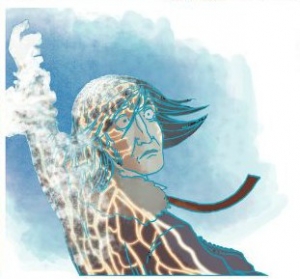 The concepts that Fialkov plays at are all brilliant in this crazy, imaginative way that comics has seemingly lacked when it comes to the “big” publishers, which is why it’s relieving to see a book like this coming from Oni Press. In having the comic being published from Oni Press, Fialkov is afforded an incredible amount of creative freedom, from the plot all the way down to the characters and settings. When it comes to the characters, Fialkov has few primary characters but plenty of ancillary characters who are great for a page or two of entertainment. With the main cast, you essentially have two to three primary characters, all of which clearly fit into the role of protagonists except for one, who through the first six issues skates the line as a somewhat antagonist but even then you can tell that really isn’t his primary service to the story throughout this arc. Your main cast consists of Jude, a seemingly regular man who has unexplored but exceptional powers, Ernest Hemingway, a famous novelist and journalist through World War I and II, and The Foreman, who is in charge of making sure purgatory runs smoothly. Jude becomes an incredibly interesting character in the way that you actually become more aware of what he could be potentially capable of than he ever is, learning an important fact about the character at around the third issue mark. He’s a character who spends a lot of this story reacting to the conflicts in his way instead of being proactive, largely because he doesn’t really even know what he’s doing yet. Hemingway is the true treat of this story though, being portrayed as an overly fictionalized version of himself with little to no shame whatsoever. He’s a forward thinker, always wanting to trudge on, to keep pushing Jude to find some semblance of a goal to achieve. He’s a character who provides just as much bravery to the story as he does comic relief, being so fictionalized that the take on the character almost feels as outrageous as it does absolutely perfect. You’ll find yourself going “Yup, that actually would be how Hemingway would act in this situation”. With The Foreman, not much is learned about the character other than he feels exactly like your average overworked, managerial worker, with constant frustrations and pressures from the “higher ups” weighing on the decisions he makes. He’s a character that one could deem as the primary antagonist if you were really trying to associate the role with any one character in the story but even then it just doesn’t feel like a fair title to saddle the character with as you can sympathize with the struggles he faces as well.
The concepts that Fialkov plays at are all brilliant in this crazy, imaginative way that comics has seemingly lacked when it comes to the “big” publishers, which is why it’s relieving to see a book like this coming from Oni Press. In having the comic being published from Oni Press, Fialkov is afforded an incredible amount of creative freedom, from the plot all the way down to the characters and settings. When it comes to the characters, Fialkov has few primary characters but plenty of ancillary characters who are great for a page or two of entertainment. With the main cast, you essentially have two to three primary characters, all of which clearly fit into the role of protagonists except for one, who through the first six issues skates the line as a somewhat antagonist but even then you can tell that really isn’t his primary service to the story throughout this arc. Your main cast consists of Jude, a seemingly regular man who has unexplored but exceptional powers, Ernest Hemingway, a famous novelist and journalist through World War I and II, and The Foreman, who is in charge of making sure purgatory runs smoothly. Jude becomes an incredibly interesting character in the way that you actually become more aware of what he could be potentially capable of than he ever is, learning an important fact about the character at around the third issue mark. He’s a character who spends a lot of this story reacting to the conflicts in his way instead of being proactive, largely because he doesn’t really even know what he’s doing yet. Hemingway is the true treat of this story though, being portrayed as an overly fictionalized version of himself with little to no shame whatsoever. He’s a forward thinker, always wanting to trudge on, to keep pushing Jude to find some semblance of a goal to achieve. He’s a character who provides just as much bravery to the story as he does comic relief, being so fictionalized that the take on the character almost feels as outrageous as it does absolutely perfect. You’ll find yourself going “Yup, that actually would be how Hemingway would act in this situation”. With The Foreman, not much is learned about the character other than he feels exactly like your average overworked, managerial worker, with constant frustrations and pressures from the “higher ups” weighing on the decisions he makes. He’s a character that one could deem as the primary antagonist if you were really trying to associate the role with any one character in the story but even then it just doesn’t feel like a fair title to saddle the character with as you can sympathize with the struggles he faces as well.
For as much inventiveness that Fialkov displays with this tale, there are definitely some harsh moments for the reader to stomach. The lack of a clear antagonist, and keeping a clear motivating goal at bay from Jude for much of this first volume results in a plot that feels a little directionless at times. Fialkov does it all in such a way that it almost feels intentional, as this comic isn’t one that follows convention but instead knowingly goes against it. Nonetheless, it hurts with the way the story is stylized as a lot of the time you feel like Fialkov is just skirting Jude and Hemingway from moment to moment, trying to fill in the blanks by having Jude discover how certain characters died or committed suicide. It ends up feeling as though these moments are just space holders between learning what Jude really is, to deciding how to help everyone in purgatory. That’s not to say that this plot is not manageable, as it has clear moments that are captivating and make you love what’s going on, it’s just that a lot of the blame falls on Jude for having such extraordinary powers but struggling to decide what to do with them. Even then you can argue that this is integral to not only the character of Jude but the story as well as the personal crisis of what to do with these sort of powers can help to develop the direction of the character going forward. In short, this comic is a brilliantly imaginative read that lets the reigns run a little too loose at times but that might have been Fialkov’s sole intention from the start.
Collects: The Life After #1-5.
Best Character: Ernest Hemingway.
Best Line Of Dialogue/Caption: “There’s a voice that tells me it’s not worth it and I’m going to miss the cooking show that’s not as good as Hell’s Kitchen thats always on and I won’t know how to get home from here and–” – Jude.
Best Scene/Moment: Jude’s daily routine – Issue 1.
Best Issue: Issue 1. The first issue of this series is about as perfect of a first issue of a comic as you could ask for. It introduces your main character, explains their life, their current conflicts, and then inverts all the action at the last moment to turn the series in a direction you wouldn’t expect. From the brilliant illustration of the monotony of life during the first few pages to the absolutely gut churning and sickening discoveries that Jude witnesses for the first time, this first issue from an artistic stand point excels in both the area of writing, artwork, and overall presentation.
Why You Should Read It: This could be the most imaginative comic you’ve ever read. The different layers of a series that almost tows the line as a black comedy/fantasy at times is utterly captivating with the way Fialkov anchors it. It’s a high concept yet still somehow simple fantasy series that knows to not take itself too seriously whilst also dealing with some dark subject matter in a way that is and also isn’t dark at the exact same time. Once you read it you’ll understand what I’m getting at. The main take away though is you’ll never read a comic with as original a take on the concept of purgatory as you’ll find in The Life After.

